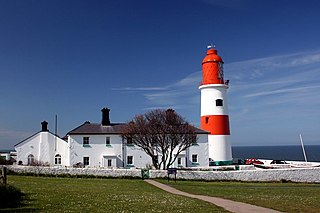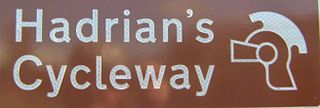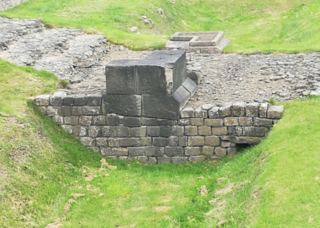Alexandra T. Croom BA FSA is a British archaeologist and museum curator.
Alexandra T. Croom BA FSA is a British archaeologist and museum curator.
Croom is the Keeper of Archaeology at Tyne & Wear Archives & Museums. [1] She was elected as a Fellow of the Society of Antiquaries of London on 29 April 2010. [2]
Croom has been involved in the planning and delivery of several exhibitions for Tyne & Wear Archives & Museum including:

There are many Roman sites in Great Britain that are open to the public. There are also many sites that do not require special access, including Roman roads, and sites that have not been uncovered.

South Tyneside is a metropolitan borough in the metropolitan county of Tyne and Wear, England.

Segedunum was a Roman fort at modern-day Wallsend, North Tyneside in North East England. The fort lay at the eastern end of Hadrian's Wall near the banks of the River Tyne. It was in use for approximately 300 years from around 122 AD to almost 400. Today Segedunum is the most thoroughly excavated fort along Hadrian's Wall, and is operated as Segedunum Roman Fort, Baths and Museum. It forms part of the Hadrian's Wall UNESCO World Heritage Site.

Wallsend is a Tyne and Wear Metro station, serving the town of Wallsend, North Tyneside in Tyne and Wear, England. It joined the network on 14 November 1982, following the opening of the fourth phase of the network, between Tynemouth and St James via Wallsend.

Arbeia was a large Roman fort in South Shields, Tyne & Wear, England, now ruined, and which has been partially reconstructed. It was first excavated in the 1870s. All modern buildings on the site were cleared in the 1970s. It is managed by Tyne and Wear Museums as Arbeia Roman Fort and Museum.

Magnis or Magna was a Roman fort near Hadrian's Wall in northern Britain. Its ruins are now known as Carvoran Roman Fort and are located near Carvoran, Northumberland, in northern England. It was built on the Stanegate frontier and Roman road, linking Coria (Corbridge) in the east to Luguvalium (Carlisle) in the west, before the building of Hadrian's Wall.

Pons Aelius, or Newcastle Roman Fort, was an auxiliary castra and small Roman settlement on Hadrian's Wall in the Roman province of Britannia Inferior, situated on the north bank of the River Tyne close to the centre of present-day Newcastle upon Tyne, and occupied between the 2nd and 4th centuries AD.
Anthony Richard Birley was a British ancient historian, archaeologist and academic. He was the son of Margaret Isabel (Goodlet) and historian and archaeologist Eric Birley.

Coria was a fort and town 2.5 miles (4.0 km) south of Hadrian's Wall, in the Roman province of Britannia. It was strategically located on the junction of a major Roman north–south road with the River Tyne and the Roman Stanegate road, which was also the first frontier line which ran east–west between Coria and Luguvalium. Corbridge Roman Site is in the village of Corbridge in the county of Northumberland.

The Vallum is a huge earthwork associated with Hadrian's Wall in England. Unique on any Roman frontier, it runs practically from coast to coast to the south of the wall. It was built a few years after the Wall.

National Route 72 of the National Cycle Network, in Northern England is also called "Hadrian's Cycleway". It starts at Kendal and makes its way around the Cumbrian coast via Barrow-in-Furness and Whitehaven to Silloth, and then across the country through Carlisle via Newcastle upon Tyne to Tynemouth at the northern shore or to South Shields at the Tyne's south shore, where the cycleway ends at Arbeia Roman Fort. Much of its route is very close to Hadrian's Wall.

The Museum of Archaeology, founded in 1833, is the archaeology museum of Durham University in England and was the second university museum in England to be open to the public. It is mostly focused on the archaeology of north east England with some national and international artefacts. The collections range from the prehistoric to the post-medieval, including the internationally important Oswald-Plique collection of Samian ware and the first complete Roman fleet diploma to be found in Britain. It is the repository for development-led archaeology finds in Durham City.

Condercum was a Roman fort on the site of the modern-day Condercum Estate in Benwell, a suburb of Newcastle upon Tyne, England. It was the third fort on Hadrian's Wall, about 6.8 miles east of Rudchester fort and only 2.4 miles west of Pons Aelius fort (Newcastle), and was situated on a hilltop 2 miles (3 km) to the west of the city.

Milecastle 0 is a possible milecastle of the Roman Hadrian's Wall which may have preexisted the fort of Segedunum. Although its existence has been suggested by historian Peter Hill, no evidence of this milecastle has been found. It is not known whether the decision to establish forts on the line of the wall predated the decision to extend the wall to Wallsend, so it is possible that this milecastle was never built.

Hadrian's Wall is a former defensive fortification of the Roman province of Britannia, begun in AD 122 in the reign of the Emperor Hadrian. Running from Wallsend on the River Tyne in the east to Bowness-on-Solway in the west of what is now northern England, it was a stone wall with large ditches in front of it and behind it that crossed the whole width of the island. Soldiers were garrisoned along the line of the wall in large forts, smaller milecastles, and intervening turrets. In addition to the wall's defensive military role, its gates may have been customs posts.
David John Breeze, OBE, FSA, FRSE, HonFSAScot, Hon MIFA is a British archaeologist, teacher and scholar of Hadrian's Wall, the Antonine Wall and the Roman army. He studied under Eric Birley and is a member of the so-called "Durham School" of archaeology. He was a close friend and colleague of the late Dr Brian Dobson.

Elizabeth Grayson Hartley, was an American archaeologist and curator. She spent most of her career as the Keeper of Archaeology at the Yorkshire Museum in York.
Lindsay Allason-Jones, is a British archaeologist and museum professional specialising in Roman material culture, Hadrian's Wall, Roman Britain, and the presence and role of women in the Roman Empire. She is currently a visiting fellow at Newcastle University.

The Witcham Gravel helmet is a Roman auxiliary cavalry helmet from the first century AD. Only the decorative copper alloy casing remains; an iron core originally fit under the casing, but has now corroded away. The cap, neck guard, and cheek guards were originally tinned, giving the appearance of a silver helmet encircled by a gold band. The helmet's distinctive feature is the presence of three hollow bosses, out of an original six, that decorate the exterior. No other Roman helmet is known to have such a feature. They may be a decorative embellishment influenced by Etruscan helmets from the sixth century BC, which had similar, lead-filled bosses, that would have deflected blades.
Paul Thomas Bidwell was a British archaeologist specialising in Roman Britain, Roman pottery, Hadrian's Wall and the Roman army in Britain.